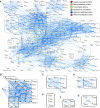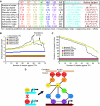Communication between levels of transcriptional control improves robustness and adaptivity
- PMID: 17130867
- PMCID: PMC1682026
- DOI: 10.1038/msb4100106
Communication between levels of transcriptional control improves robustness and adaptivity
Abstract
Regulation of eukaryotic gene expression depends on groups of related proteins acting at the levels of chromatin organization, transcriptional initiation, RNA processing, and nuclear transport. However, a unified understanding of how these different levels of transcriptional control interact has been lacking. Here, we combine genome-wide protein-DNA binding data from multiple sources to infer the connections between functional groups of regulators in Saccharomyces cerevisiae. Our resulting transcriptional network uncovers novel biological relationships; supporting experiments confirm new associations between actively transcribed genes and Sir2 and Esc1, two proteins normally linked to silencing chromatin. Analysis of the regulatory network also reveals an elegant architecture for transcriptional control. Using communication theory, we show that most protein regulators prefer to form modules within their functional class, whereas essential proteins maintain the sparse connections between different classes. Moreover, we provide evidence that communication between different regulatory groups improves the robustness and adaptivity of the cell.
Figures





References
-
- Albert R, Jeong H, Barabasi AL (2000) Error and attack tolerance of complex networks. Nature 406: 378–382 - PubMed
-
- Balaji S, Babu MM, Iyer LM, Luscombe NM, Aravind L (2006a) Comprehensive analysis of combinatorial regulation using the transcriptional regulatory network of yeast. J Mol Biol 360: 213–227 - PubMed
-
- Balaji S, Iyer LM, Aravind L, Babu MM (2006b) Uncovering a hidden distributed architecture behind scale-free transcriptional regulatory networks. J Mol Biol 360: 204–212 - PubMed
-
- Bar-Joseph Z, Gerber GK, Lee TI, Rinaldi NJ, Yoo JY, Robert F, Gordon DB, Fraenkel E, Jaakkola TS, Young RA, Gifford DK (2003) Computational discovery of gene modules and regulatory networks. Nat Biotechnol 21: 1337–1342 - PubMed
-
- Barabasi AL, Oltvai ZN (2004) Network biology: understanding the cell's functional organization. Nat Rev Genet 5: 101–113 - PubMed
Publication types
MeSH terms
Substances
LinkOut - more resources
Full Text Sources
Other Literature Sources
Molecular Biology Databases

